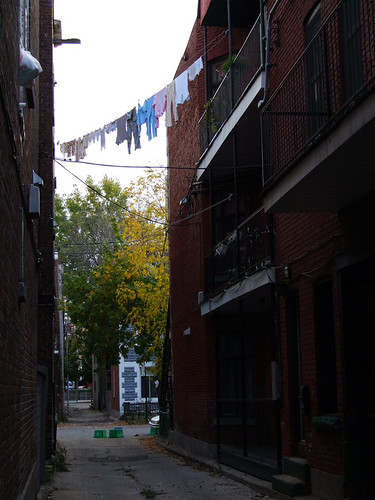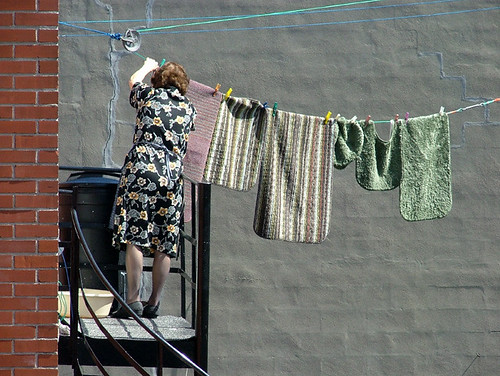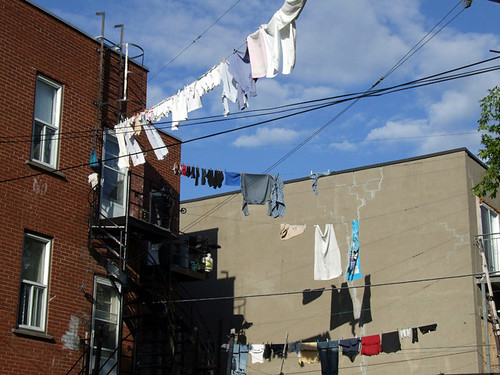Nobody hangs their laundry out to dry in Calgary. In fact, there are hardly any clothelines. My grandmother’s house had one, but I don’t think she ever used it. She, like everyone I knew while growing up there, had a washer and dryer set tucked neatly in a musty corner of her basement, across from a half-century-old furnace.
It was an eye-opening experience to travel to Newfoundland as a teenager, where I discovered that St. John’s was precisely the opposite of Calgary: everyone had clotheslines. Clothes hung over alleyways and backyards, billowing in the salty Atlantic breeze like flags of chores vanquished. There was something inexplicably romantic, something timeless, about clothes drying on lines, whether in the city or in a stark outport on the Avalon Peninsula.
 Montreal is similar to St. John’s, at least in that regard. Here, the clothesline tradition never really died. Although they’re less prevalent today than in the past, you’ll still see an abundance of them if you wander down the laneways of just about any neighbourhood. Immigrant neighbourhoods in particular have a ton of clotheslines, probably because they’re home to so many people who come from countries where drying your clothes outside is still the norm. I remember, earlier this fall, driving east through St. Michel on the elevated Metropolitan Expressway, staring at long rows of triplexes tied together by strands of billowing clothes.
Montreal is similar to St. John’s, at least in that regard. Here, the clothesline tradition never really died. Although they’re less prevalent today than in the past, you’ll still see an abundance of them if you wander down the laneways of just about any neighbourhood. Immigrant neighbourhoods in particular have a ton of clotheslines, probably because they’re home to so many people who come from countries where drying your clothes outside is still the norm. I remember, earlier this fall, driving east through St. Michel on the elevated Metropolitan Expressway, staring at long rows of triplexes tied together by strands of billowing clothes.
I wouldn’t be surprised if that kind of scene became even more common in the future. That’s because clotheslines are no longer just quaint — they’re fashionable. The growing marketability of anything “green” has led to a resurgence of interest in drying clothes outside. It’s cheaper than clothes dryers, which can consume as much as 900 kilowatt hours of energy per year, and better for your clothes. According to La Presse, which extolled the benefits of clotheslines last summer, the sun eliminates odours and removes stains, and is easier on natural fibres than clothes dryers.
But, as much as I like to know that the sun can whiten my whites, it’s the clothesline aesthetic that really appeals to me. I’m still charmed by the sight of them, which is good because they’re ubiquitous in my back alley from March until November. More than that, though, clotheslines domesticate the street. We’ve spent so much effort over past half-century trying to sterilize our cities, to turn them into machines, that we need these kinds of reminders that they are, first and foremost, places where people live, messy as that may be.
Still, prejudices linger. Many new subdivisions include provisions in house purchase agreements that ban residents from drying their clothes outside. It’s a class thing more than anything else, since clotheslines are still associated by many with poverty. There has been a clear shift in attitude, however. Earlier this month, Ontario’s environment minister announced that he wants to override those clothesline bans.
I’m not alone in enjoying the look of clotheslines, either. There are plenty of Flickr groups dedicated to clotheslines, including one called Les cordes à linge de Montréal.



3 comments
clotheslines punctuate the density and the brick and the low rise that is montréal. Vive le clothesline! What a great way to brighten the neighbourhood, reduce energy usage and activate our less lively spaces!
Let the calgary hogs run their driers until the oil runs dry….
I talked about this issues a few months ago so I’m glad to see it’s still being talked about. I see clotheslines and know that people live there, that they’re comfortable enough to hang their clothes out.
Clotheslines, in my perception, haven’t widely caught on as a green alternative in some circles because there isn’t much to sell to people. A line, some clothes pins and a wheel is about all you need. I find people are more comfortable buying something with “GREEN” slapped across the label to feel environmentally conscious. Clotheslines are a practical and unglamourous thing that your grandparents did. People don’t seem to see that all those things previous generations did to avoid being wasteful (like during the Depression) are also good for the environment.
Born in 1940, I grew up in St John NB. Everyone had a clothesline and I used one into my early thirties. Some houses even had a window designed just for hanging out the laundry. That was for ground floors and it was built higher in the wall. It was accessed by way of stairs to an elevated ramp, the window opened on a hinge and the clothes pins were right there. It was built that way so your line could be high and a loaded line wouldn’t drag on the ground. That was pretty fancy back then.
I remember bed sheets and diapers. Nothing smelled better than our house when they were brought indoors. Fresh laundry! I miss it.